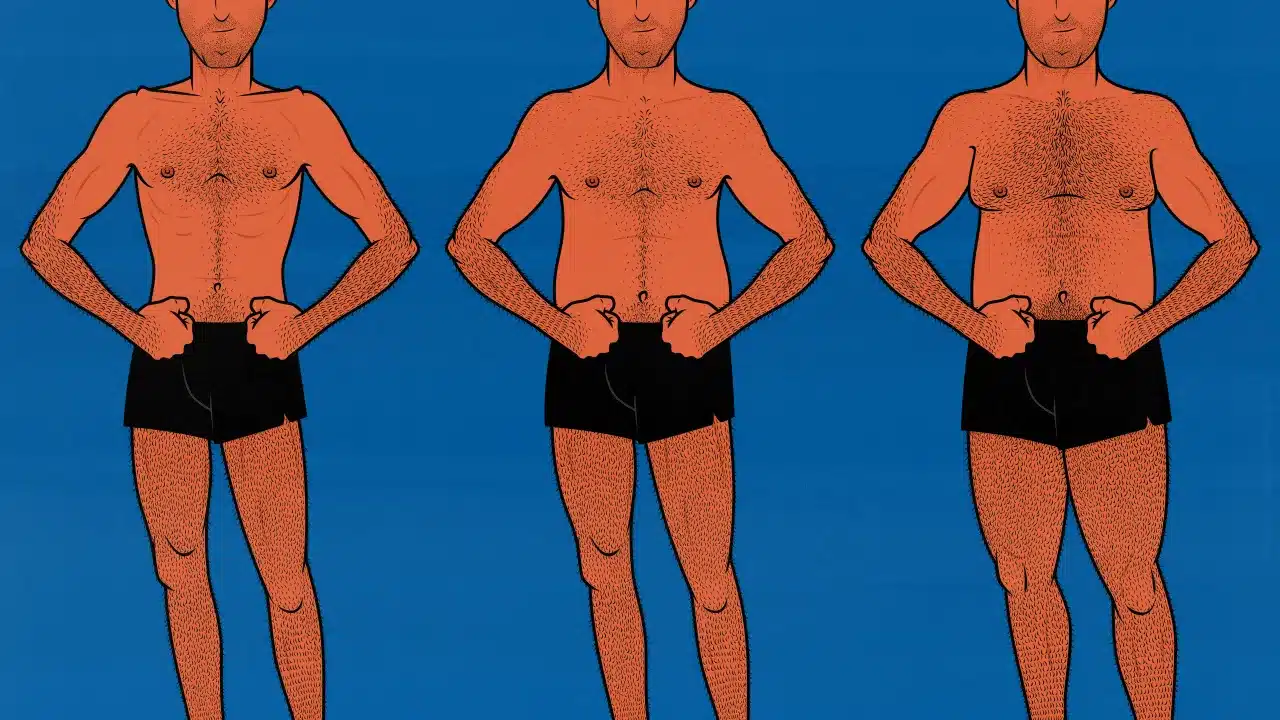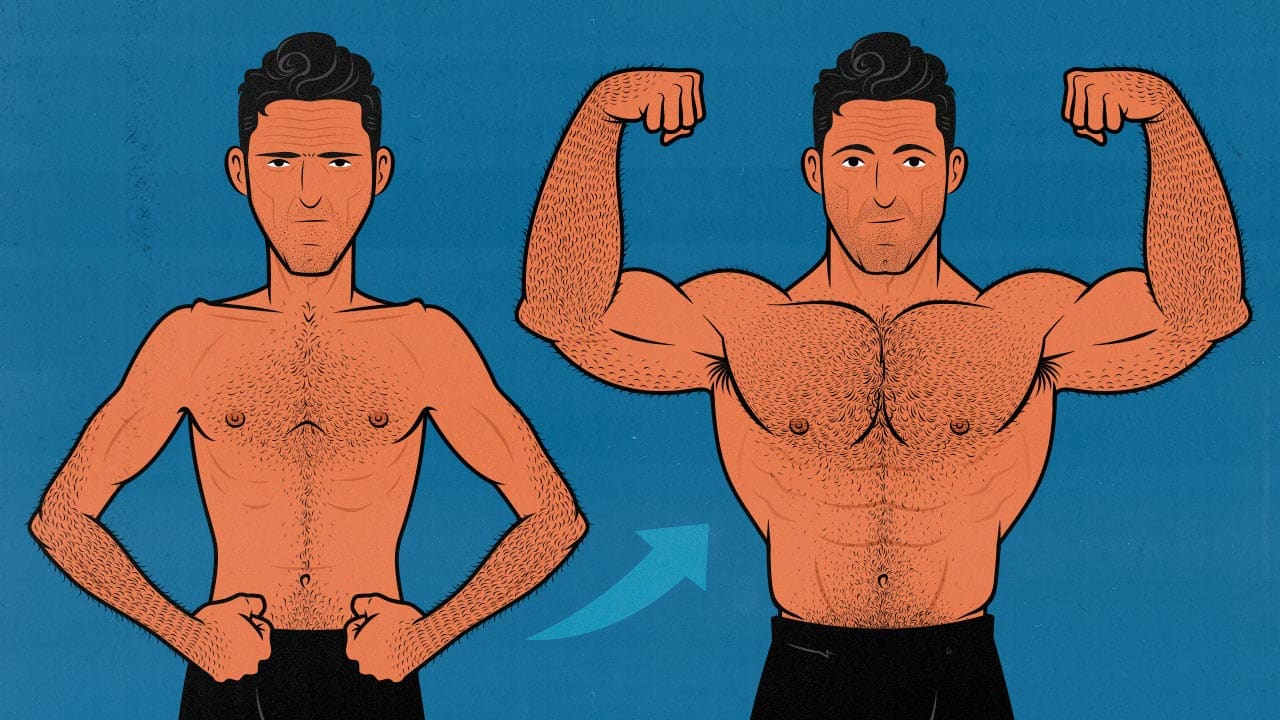Posts by Shane Duquette
What is Skinny Fat? And How to Know If You Are
“Skinny fat” is when you have a “skinny” amount of muscle combined with a “fat” amount of body fat. It has a specific look to it. Fat accumulates around your abs and organs, giving you skinny arms and legs with a belly.
In the research, it’s usually called normal-weight obesity, and it comes along with a few health problems (study). Having less muscle means less strength, bone density, and less blood sugar control. Having too much fat means hampered hormone production, a higher risk of heart disease, and, again, worse blood sugar control.
There’s a heritable component to skinny fatness. Indians and other South Asians are particularly predisposed to it (study). It seems that people with an ancestral history of enduring famines develop a tendency to store more body fat, becoming overfat even when they aren’t overweight. That might sound bad, but remember that most people are overfat and overweight, which is worse.
Skinny fatness isn’t your genetic destiny. It’s what happens when you get out of shape. That means you can get rid of it. There are a few different ways to do that, and you can combine them all together to get rid of your skinny fatness even faster.
The good news is that because your body weight isn’t a problem, you won’t need to manipulate your calorie intake very much, which is usually the hardest part of building muscle and burning fat.
There’s also an easy way to tell if you’re skinny fat. All you need is a measuring tape.
Read MoreThe Bulking Guide for Skinny Beginners
Bulking is often derided as the fool’s way of building muscle. That’s true on average. Most people are already overweight. The last thing they need is more weight. But if you’re thin, underweight, or lean, bulking is by far the best way to build muscle.
In this guide, we’ll teach you exactly how to bulk.
Delve DeeperThe Best Fast Food Restaurants for Bulking
We get this question a fair bit. Most people associate fast-food restaurants with processed junk food, but that only describes some of them. If you want to get a healthy, high-calorie bulking meal from a fast-food restaurant, you can. There are some really good options.
Read MoreHow Age Affects Muscle Growth
We’ve helped 15,000 skinny people bulk up, ranging from 18 to 80 years old. Marco has coached college, professional, and Olympic athletes revelling in the peak of their athletic performance. He’s also coached sedentary desk workers in their 20s, 40s, 60s, and 80s.
What we’ve seen matches what we see in the research, and what the research shows is shocking. We have pictures. You’re going to love this.
Read MoreHow Often Should You Lift Weights to Build Muscle?
Most guys assume that training more often stimulates more muscle growth. If that were true, then to build muscle faster, you’d train as often as possible—maybe as many as 5 or even 6 days per week. To do any less would be to miss out on muscle gains.
That’s the wrong way to think about it.
Read MoreHow to Make High-Calorie Bulking Smoothies (to Gain Weight)
When you blend whole foods into smoothies, they keep their nutritional value, they get quicker to prepare and eat, and they don’t leave you feeling as full. That’s why they’re so popular in the fitness industry. Smoothies are the easiest way to consume several servings of protein, fruits, veggies, omega-3s, phytonutrients, and fibre.
If you make a high-calorie bulking smoothie, it can shift you into an effortless calorie surplus, making it much easier to gain weight (study). We’ve used these smoothies to gain nearly 70 pounds each. We’ve also used them with thousands of clients, ranging from everyday people all the way up to professional and Olympic athletes.
Read MoreHow Much Protein Powder Can You Have Per Day?
One of the most common questions we get is how much protein powder is too much protein powder? One scoop of whey per day is probably fine, right? But what about 2 scoops? 3 scoops? 4?
I’ve seen dozens of muscle-building studies where the researchers give participants upwards of 60 or even 90 grams of protein per day for several months in a row, measuring what effects it has on muscle growth.
There are other studies looking directly at how much protein powder you can safely have per day.
Read MoreThe Best Time to Have a Protein Shake
You can have a protein shake at any time. The most important thing is to consume enough protein overall. Still, some times are better than others.
Maybe you’ve heard of a bodybuilder who wakes up in the middle of the night to chug the shake they’ve left on their bedside table. You can do better than that.
And what about the anabolic window? Should you be having protein shakes before and after working out? Maybe, yes.
Read MoreHow to Build Much Broader Shoulders
Broad shoulders are touted as one of the most attractive features a man can possess. That’s not wrong. You can build broader shoulders, and when you do, it will improve your appearance. But that’s not quite how aesthetics works. In fact, it’s almost entirely backwards. More on that in a moment.
Then there’s the issue of bone structure. The length of your collarbones is largely genetic, and that’s a big part of determining how wide your shoulders can get. If you have a thinner build, it’s easy to assume you’re fated to have narrow shoulders. But that isn’t quite right, either. I’ve added over a dozen inches to my shoulder circumference.
We’ve helped over 15,000 people bulk up, tracking their progress along the way. If you spend the next 6 months bulking up your shoulder muscles, how much broader can you get them? To answer that question, we tracked our client results. We’ll show you their before/after photos and measurements to give you a realistic idea of how much broader you can get your shoulders.
Read MoreHow Long Should You Bulk For?
In theory, you could bulk slowly over several years. That’s what some natural bodybuilders do. They eat in a small calorie surplus as part of their regular lifestyle, only stopping when they need to lean down for a bodybuilding competition. However, they have fierce appetites and large stomachs, making it relatively easy to gain weight.
For most skinny guys, eating in a sustained calorie surplus is incredibly difficult, not least because our metabolisms adapt to larger calorie intakes. You might start a bulk by eating 3,000 calories per day. A few months later you might struggle to gain weight on 4,000 calories. You could add even more calories to your diet, but that’s easier said than eaten.
As a naturally skinny guy with a meagre appetite, the thought of bulking forever fills me with a deep sense of dread, leaving little room for extra food. My first and second bulks were 3 months each, which was enough time for me to gain a lean 45 pounds. My third bulk was 5 months long. The longest I’ve made it was 8.
Over the past 10 years of helping over 10,000 guys bulk up, we’ve developed a system for figuring out how long to bulk and when to stop.
Read More









